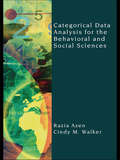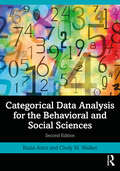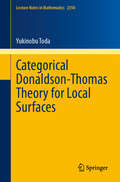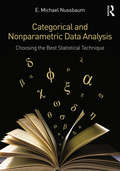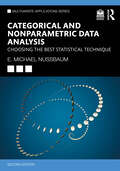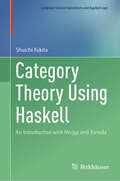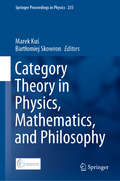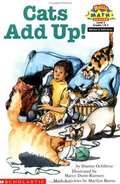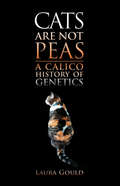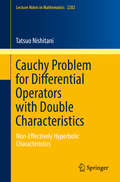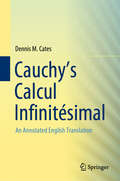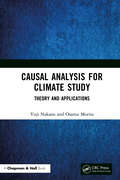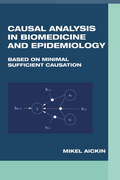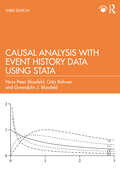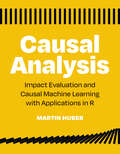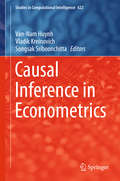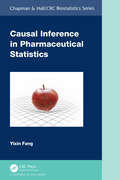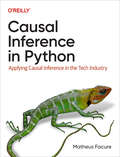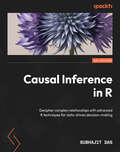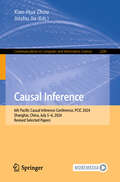- Table View
- List View
Categorical Data Analysis for the Behavioral and Social Sciences
by Razia Azen Cindy M. WalkerFeaturing a practical approach with numerous examples, this book focuses on helping the reader develop a conceptual, rather than technical, understanding of categorical methods, making it a much more accessible text than others on the market. The authors cover common categorical analyses and emphasize specific research questions that can be addressed by each analytic procedure so that readers are able to address the research questions they wish to answer. To achieve this goal, the authors: Review the theoretical implications and assumptions underlying each of the procedures Present each concept in general terms and illustrate each with a practical example Demonstrate the analyses using SPSS and SAS and show the interpretation of the results provided by these programs. A "Look Ahead" section at the beginning of each chapter provides an overview of the material covered so that the reader knows what to expect. This is followed by one or more research questions that can be addressed using the procedure(s) covered in the chapter. A theoretical presentation of the material is provided and illustrated using realistic examples from the behavioral and social sciences. To further enhance accessibility, the new procedures introduced in the book are explicitly related to analytic procedures covered in earlier statistics courses, such as ANOVA and linear regression. Throughout each chapter the authors use practical examples to demonstrate how to obtain and interpret statistical output in both SPSS and SAS. Their emphasis on the relationship between the initial research question, the use of the software to carry out the analysis, and the interpretation of the output as it relates to the initial research question, allows readers to easily apply the material to their own research. The data sets for executing chapter examples using SAS Version 9.1.3 and/or IBM SPSS Version 18 are available on a book specific web site. These data sets and syntax allow readers to quickly run the programs and obtain the appropriate output. The book also includes both conceptual and analytic end-of-chapter exercises to assist instructors and students in evaluating the understanding of the material covered in each chapter. This book covers the most commonly used categorical data analysis procedures. It is written for those without an extensive mathematical background, and is ideal for graduate courses in categorical data analysis or cross-classified data analysis taught in departments of psychology, human development & family studies, sociology, education, and business. Researchers in these disciplines interested in applying these procedures to their own research will appreciate this book’s accessible approach.
Categorical Data Analysis for the Behavioral and Social Sciences
by Razia Azen Cindy M. WalkerFeaturing a practical approach with numerous examples, the second edition of Categorical Data Analysis for the Behavioral and Social Sciences focuses on helping the reader develop a conceptual understanding of categorical methods, making it a much more accessible text than others on the market. The authors cover common categorical analysis methods and emphasize specific research questions that can be addressed by each analytic procedure, including how to obtain results using SPSS, SAS, and R, so that readers are able to address the research questions they wish to answer. Each chapter begins with a "Look Ahead" section to highlight key content. This is followed by an in-depth focus and explanation of the relationship between the initial research question, the use of software to perform the analyses, and how to interpret the output substantively. Included at the end of each chapter are a range of software examples and questions to test knowledge. New to the second edition: The addition of R syntax for all analyses and an update of SPSS and SAS syntax. The addition of a new chapter on GLMMs. Clarification of concepts and ideas that graduate students found confusing, including revised problems at the end of the chapters. Written for those without an extensive mathematical background, this book is ideal for a graduate course in categorical data analysis taught in departments of psychology, educational psychology, human development and family studies, sociology, public health, and business. Researchers in these disciplines interested in applying these procedures will also appreciate this book’s accessible approach.
Categorical Donaldson-Thomas Theory for Local Surfaces (Lecture Notes in Mathematics #2350)
by Yukinobu TodaThis book provides an introduction to categorical Donaldson-Thomas (DT) theory, a rapidly developing field which has close links to enumerative geometry, birational geometry, geometric representation theory and classical moduli problems in algebraic geometry. The focus is on local surfaces, i.e. the total spaces of canonical line bundles on algebraic surfaces, which form an interesting class of Calabi-Yau 3-folds. Using Koszul duality equivalences and singular support theory, dg-categories are constructed which categorify Donaldson-Thomas invariants on local surfaces. The DT invariants virtually count stable coherent sheaves on Calabi-Yau 3-folds, and play an important role in modern enumerative geometry, representation theory and mathematical physics. Requiring a basic knowledge of algebraic geometry and homological algebra, this monograph is primarily addressed to researchers working in enumerative geometry, especially Donaldson-Thomas theory, derived categories of coherent sheaves, and related areas.
Categorical Homotopy Theory
by Emily RiehlThis book develops abstract homotopy theory from the categorical perspective with a particular focus on examples. Part I discusses two competing perspectives by which one typically first encounters homotopy (co)limits: either as derived functors definable when the appropriate diagram categories admit a compatible model structure, or through particular formulae that give the right notion in certain examples. Emily Riehl unifies these seemingly rival perspectives and demonstrates that model structures on diagram categories are irrelevant. Homotopy (co)limits are explained to be a special case of weighted (co)limits, a foundational topic in enriched category theory. In Part II, Riehl further examines this topic, separating categorical arguments from homotopical ones. Part III treats the most ubiquitous axiomatic framework for homotopy theory - Quillen's model categories. Here, Riehl simplifies familiar model categorical lemmas and definitions by focusing on weak factorization systems. Part IV introduces quasi-categories and homotopy coherence.
Categorical and Nonparametric Data Analysis: Choosing the Best Statistical Technique (Multivariate Applications Series)
by E. Michael NussbaumFeaturing in-depth coverage of categorical and nonparametric statistics, this book provides a conceptual framework for choosing the most appropriate type of test in various research scenarios. Class tested at the University of Nevada, the book's clear explanations of the underlying assumptions, computer simulations, and Exploring the Concept boxes help reduce reader anxiety. Problems inspired by actual studies provide meaningful illustrations of the techniques. The underlying assumptions of each test and the factors that impact validity and statistical power are reviewed so readers can explain their assumptions and how tests work in future publications. Numerous examples from psychology, education, and other social sciences demonstrate varied applications of the material. Basic statistics and probability are reviewed for those who need a refresher. Mathematical derivations are placed in optional appendices for those interested in this detailed coverage. Highlights include the following: Unique coverage of categorical and nonparametric statistics better prepares readers to select the best technique for their particular research project; however, some chapters can be omitted entirely if preferred. Step-by-step examples of each test help readers see how the material is applied in a variety of disciplines. Although the book can be used with any program, examples of how to use the tests in SPSS and Excel foster conceptual understanding. Exploring the Concept boxes integrated throughout prompt students to review key material and draw links between the concepts to deepen understanding. Problems in each chapter help readers test their understanding of the material. Emphasis on selecting tests that maximize power helps readers avoid "marginally" significant results. Website (www.routledge.com/9781138787827) features datasets for the book's examples and problems, and for the instructor, PowerPoint slides, sample syllabi, answers to the even-numbered problems, and Excel data sets for lecture purposes. Intended for individual or combined graduate or advanced undergraduate courses in categorical and nonparametric data analysis, cross-classified data analysis, advanced statistics and/or quantitative techniques taught in psychology, education, human development, sociology, political science, and other social and life sciences, the book also appeals to researchers in these disciplines. The nonparametric chapters can be deleted if preferred. Prerequisites include knowledge of t tests and ANOVA.
Categorical and Nonparametric Data Analysis: Choosing the Best Statistical Technique (Multivariate Applications Series)
by E. Michael NussbaumNow in its second edition, this book provides a focused, comprehensive overview of both categorical and nonparametric statistics, offering a conceptual framework for choosing the most appropriate test in various scenarios. The book’s clear explanations and Exploring the Concept boxes help reduce reader anxiety. Problems inspired by actual studies provide meaningful illustrations of these techniques. Basic statistics and probability are reviewed for those needing a refresher with mathematical derivations placed in optional appendices.Highlights include the following:• Three chapters co-authored with Edgar Brunner address modern nonparametric techniques, along with accompanying R code.• Unique coverage of both categorical and nonparametric statistics better prepares readers to select the best technique for particular research projects.• Designed to be used with most statistical packages, clear examples of how to use the tests in SPSS, R, and Excel foster conceptual understanding.• Exploring the Concept boxes integrated throughout prompt students to draw links between the concepts to deepen understanding.• Fully developed Instructor and Student Resources featuring datasets for the book's problems and a guide to R, and for the instructor PowerPoints, author's syllabus, and answers to even-numbered problems.Intended for graduate or advanced undergraduate courses in categorical and nonparametric statistics taught in psychology, education, human development, sociology, political science, and other social and life sciences.
Category Theory Using Haskell: An Introduction with Moggi and Yoneda (Computer Science Foundations and Applied Logic)
by Shuichi YukitaThis unique book offers an introductory course on category theory, which became a working language in algebraic geometry and number theory in the 1950s and began to spread to logic and computer science soon after it was created. Offering excellent use of helpful examples in Haskell, the work covers (among other things) concepts of functors, natural transformations, monads, adjoints, universality, category equivalence, and many others. The main goal is to understand the Yoneda lemma, which can be used to reverse-engineer the implementation of a function. Later chapters offer more insights into computer science, including computation with output, nondeterministic computation, and continuation passing. Topics and features: Contains rigorous mathematical arguments to support the theory Provides numerous Haskell code-implementing examples Engages with plentiful diagram chasing, with special emphasis on the design patterns for constructing a large diagram out of basic small pieces Offers insights into category theory to quantum computing and the foundation of computing discipline Serves as a preparatory course for monoidal categories and higher categories The work will be useful to undergraduate students in computer science who have enough background in college mathematics such as linear algebra and basics in Haskell polymorphic functions. Further, it will appeal to graduate students and researchers in computing disciplines who want to newly acquire serious knowledge of category theory.
Category Theory for the Sciences
by David I. SpivakAn introduction to category theory as a rigorous, flexible, and coherent modeling language that can be used across the sciences.Category theory was invented in the 1940s to unify and synthesize different areas in mathematics, and it has proven remarkably successful in enabling powerful communication between disparate fields and subfields within mathematics. This book shows that category theory can be useful outside of mathematics as a rigorous, flexible, and coherent modeling language throughout the sciences. Information is inherently dynamic; the same ideas can be organized and reorganized in countless ways, and the ability to translate between such organizational structures is becoming increasingly important in the sciences. Category theory offers a unifying framework for information modeling that can facilitate the translation of knowledge between disciplines.Written in an engaging and straightforward style, and assuming little background in mathematics, the book is rigorous but accessible to non-mathematicians. Using databases as an entry to category theory, it begins with sets and functions, then introduces the reader to notions that are fundamental in mathematics: monoids, groups, orders, and graphs—categories in disguise. After explaining the “big three” concepts of category theory—categories, functors, and natural transformations—the book covers other topics, including limits, colimits, functor categories, sheaves, monads, and operads. The book explains category theory by examples and exercises rather than focusing on theorems and proofs. It includes more than 300 exercises, with solutions.Category Theory for the Sciences is intended to create a bridge between the vast array of mathematical concepts used by mathematicians and the models and frameworks of such scientific disciplines as computation, neuroscience, and physics.
Category Theory in Context (Aurora: Dover Modern Math Originals)
by Emily RiehlCategory theory has provided the foundations for many of the twentieth century's greatest advances in pure mathematics. This concise, original text for a one-semester course on the subject is derived from courses that author Emily Riehl taught at Harvard and Johns Hopkins Universities. The treatment introduces the essential concepts of category theory: categories, functors, natural transformations, the Yoneda lemma, limits and colimits, adjunctions, monads, and other topics. Suitable for advanced undergraduates and graduate students in mathematics, the text provides tools for understanding and attacking difficult problems in algebra, number theory, algebraic geometry, and algebraic topology. Drawing upon a broad range of mathematical examples from the categorical perspective, the author illustrates how the concepts and constructions of category theory arise from and illuminate more basic mathematical ideas. Prerequisites are limited to familiarity with some basic set theory and logic.
Category Theory in Physics, Mathematics, and Philosophy (Springer Proceedings in Physics #235)
by Marek Kuś Bartłomiej SkowronThe contributions gathered here demonstrate how categorical ontology can provide a basis for linking three important basic sciences: mathematics, physics, and philosophy. Category theory is a new formal ontology that shifts the main focus from objects to processes.The book approaches formal ontology in the original sense put forward by the philosopher Edmund Husserl, namely as a science that deals with entities that can be exemplified in all spheres and domains of reality. It is a dynamic, processual, and non-substantial ontology in which all entities can be treated as transformations, and in which objects are merely the sources and aims of these transformations.Thus, in a rather surprising way, when employed as a formal ontology, category theory can unite seemingly disparate disciplines in contemporary science and the humanities, such as physics, mathematics and philosophy, but also computer and complex systems science.
Catenary Optics
by Xiangang LuoThis book offers the first comprehensive introduction to the optical properties of the catenary function, and includes more than 200 figures. Related topics addressed here include the photonic spin Hall effect in inhomogeneous anisotropic materials, coupling of evanescent waves in complex structures, etc. After familiarizing readers with these new physical phenomena, the book highlights their applications in plasmonic nanolithography, flat optical elements, perfect electromagnetic absorbers and polarization converters. The book will appeal to a wide range of readers: while researchers will find new inspirations for historical studies combining mechanics, mathematics, and optics, students will gain a wealth of multidisciplinary knowledge required in many related areas. In fact, the catenary function was deemed to be a “true mathematical and mechanical form” in architecture by Robert Hooke in the 1670s. The discovery of the mathematical form of catenaries is attributed to Gottfried Leibniz, Christiaan Huygens and Johann Bernoulli in 1691. As the founders of wave optics, however, Hooke and Huygens did not recognize the importance of catenaries in optics. It is only in recent decades that the link between catenaries and optics has been established.
Cats Add Up! (Hello Reader! Math)
by Marilyn Burns Dianne Ochiltree Marcy Dunn-RamseyIncluding a complementary article showing parents how to explore the mathematical concepts involved in the story with their children, a humorous tale for young pet lovers demonstrates the mechanics of addition, subtraction, and multiplication. Original.
Cats Are Not Peas: A Calico History of Genetics, Second Edition
by Laura GouldThe Vets Turn Pale. . . George, a male calico, was a genetic anomaly, a manifestation of something that isn't supposed to happen, a creature so rare that even most veterinarians have never seen one. His curious existence sparked Laura Gould's long search through the archives of genetics to unearth the charming and valiant roles played by early cat
Cauchy Problem for Differential Operators with Double Characteristics: Non-Effectively Hyperbolic Characteristics (Lecture Notes in Mathematics #2202)
by Tatsuo NishitaniCombining geometrical and microlocal tools, this monograph gives detailed proofs of many well/ill-posed results related to the Cauchy problem for differential operators with non-effectively hyperbolic double characteristics. Previously scattered over numerous different publications, the results are presented from the viewpoint that the Hamilton map and the geometry of bicharacteristics completely characterizes the well/ill-posedness of the Cauchy problem. A doubly characteristic point of a differential operator P of order m (i. e. one where Pm = dPm = 0) is effectively hyperbolic if the Hamilton map FPm has real non-zero eigen values. When the characteristics are at most double and every double characteristic is effectively hyperbolic, the Cauchy problem for P can be solved for arbitrary lower order terms. If there is a non-effectively hyperbolic characteristic, solvability requires the subprincipal symbol of P to lie between −P#65533;j and P#65533;j , where i#65533;j are the positive imaginary eigenvalues of FPm . Moreover, if 0 is an eigenvalue of FPm with corresponding 4 #65533; 4 Jordan block, the spectral structure of FPm is insufficient to determine whether the Cauchy problem is well-posed and the behavior of bicharacteristics near the doubly characteristic manifold plays a crucial role.
Cauchy’s Calcul Infinitésimal
by Dennis M. CatesThis book is a complete English translation of Augustin-Louis Cauchy's historic 1823 text (his first devoted to calculus), Résumé des leçons sur le calcul infinitésimal, "Summary of Lectures on the Infinitesimal Calculus," originally written to benefit his École Polytechnic students in Paris. Within this single text, Cauchy succinctly lays out and rigorously develops all of the topics one encounters in an introductory study of the calculus, from his classic definition of the limit to his detailed analysis of the convergence properties of infinite series. In between, the reader will find a full treatment of differential and integral calculus, including the main theorems of calculus and detailed methods of differentiating and integrating a wide variety of functions. Real, single variable calculus is the main focus of the text, but Cauchy spends ample time exploring the extension of his rigorous development to include functions of multiple variables as well as complex functions. <p><p> This translation maintains the same notation and terminology of Cauchy's original work in the hope of delivering as honest and true a Cauchy experience as possible so that the modern reader can experience his work as it may have been like 200 years ago. This book can be used with advantage today by anyone interested in the history of the calculus and analysis. In addition, it will serve as a particularly valuable supplement to a traditional calculus text for those readers who desire a way to create more texture in a conventional calculus class through the introduction of original historical sources.
Causal Analysis for Climate Study: Theory and Applications
by Osamu Morita Yuji NakanoThis book offers the theory of causal analysis and its applications. The authors have developed this book in relation to its applications to four climatological phenomena to prove the theory of causal analysis in time sequential data analysis.Local Causal Test and the Partial Causal Test are used to study the theory of causal analysis. These are then applied to understand the climate effects of the eruption at Mt. Pinatubo, the effect of the El Niño and Southern Oscillation (ENSO), and the North Atlantic Oscillation (NAO). The reader learns about Test(S), a statistical test used to determine if the statistical properties of the data, such as mean and variance, remain constant over time within a local window. The authors also use the Stationary Test and Causality Test in time series to explore relationships within a localized subset of data as witnessed from the climate phenomenon. The book looks at the eruption at Mt. Pinatubo, ENSO, and NAO and applies causal theory to study the resultant air temperature at the 1000 hPa pressure level, geopotential height of 1000 hPa pressure surface, and surface precipitation. The program code of the causal analysis is offered for readers to be able to reconfirm the results and apply it to other time-sequential data.This book is useful for researchers and graduate students of applied mathematics, physics, geophysics, meteorology, oceanography, engineering technology, and economics.
Causal Analysis in Biomedicine and Epidemiology: Based on Minimal Sufficient Causation
by Mikel Aickin"Provides current models, tools, and examples for the formulation and evaluation of scientific hypotheses in causal terms. Introduces a new method of model parametritization. Illustrates structural equations and graphical elements for complex causal systems."
Causal Analysis with Event History Data Using Stata
by Hans-Peter Blossfeld Götz Rohwer Gwendolin J. BlossfeldThis third edition of Causal Analysis with Event History Data Using Stata provides an updated introduction to event history modeling along with many instructive Stata examples. Using the latest Stata software, each of these practical examples develops a research question, points to useful contextual background information, gives a brief account of the underlying statistical concepts, describes the organization of input data and the application of Stata statistical procedures, and assists the reader in interpreting the content of the results obtained. Emphasizing the strengths and limitations of continuous-time event history analysis in different fields of social science applications, this book demonstrates that event history models provide a useful approach to uncover causal relation- ships or to map a system of causal relationships. In particular, this book demonstrates how long-term processes can be studied, how different forms of duration dependencies can be estimated using nonparametric, parametric and semiparametric models, and how parallel and interdependent dynamic systems can be analyzed from a causal-analytical point of view using the method of episode splitting. The book also shows how changing contextual information at the micro, meso and macro levels can be easily integrated into a dynamic analysis of longitudinal data. Finally, the book addresses the problem of unobserved heterogeneity of time-constant and time-dependent omitted variables and makes suggestions for dealing with these sometimes difficult methodological problems.Causal Analysis with Event History Data Using Stata is an invaluable resource for both novice and experienced researchers from a variety of fields (e.g. sociology, economics, political science, education, psychology, demography, epidemiology, management research and organizational studies, as well as medicine and clinical applications) who need an introductory textbook on continuous-time event history analysis and who are looking for a practical handbook for their longitudinal research.
Causal Analysis: Impact Evaluation and Causal Machine Learning with Applications in R
by Martin HuberA comprehensive and cutting-edge introduction to quantitative methods of causal analysis, including new trends in machine learning.Reasoning about cause and effect—the consequence of doing one thing versus another—is an integral part of our lives as human beings. In an increasingly digital and data-driven economy, the importance of sophisticated causal analysis only deepens. Presenting the most important quantitative methods for evaluating causal effects, this textbook provides graduate students and researchers with a clear and comprehensive introduction to the causal analysis of empirical data. Martin Huber&’s accessible approach highlights the intuition and motivation behind various methods while also providing formal discussions of key concepts using statistical notation. Causal Analysis covers several methodological developments not covered in other texts, including new trends in machine learning, the evaluation of interaction or interference effects, and recent research designs such as bunching or kink designs.Most complete and cutting-edge introduction to causal analysis, including causal machine learning Clean presentation of rigorous material avoids extraneous detail and emphasizes conceptual analogies over statistical notationSupplies a range of applications and practical examples using R
Causal Inference in Econometrics (Studies in Computational Intelligence #622)
by Van-Nam Huynh Vladik Kreinovich Songsak SriboonchittaThis bookis devoted to the analysis of causal inference which is one of the most difficult tasks in dataanalysis: when two phenomena are observed to be related, it is often difficultto decide whether one of them causally influences the other one, or whetherthese two phenomena have a common cause. This analysis is the main focus ofthis volume. To get agood understanding of the causal inference, it is important to have models ofeconomic phenomena which are as accurate as possible. Because of this need,this volume also contains papers that use non-traditional economic models, suchas fuzzy models and models obtained by using neural networks and data miningtechniques. It also contains papers that apply different econometric models toanalyze real-life economic dependencies.
Causal Inference in Pharmaceutical Statistics (Chapman & Hall/CRC Biostatistics Series)
by Yixin FangCausal Inference in Pharmaceutical Statistics introduces the basic concepts and fundamental methods of causal inference relevant to pharmaceutical statistics. This book covers causal thinking for different types of commonly used study designs in the pharmaceutical industry, including but not limited to randomized controlled clinical trials, longitudinal studies, singlearm clinical trials with external controls, and real-world evidence studies. The book starts with the central questions in drug development and licensing, takes the reader through the basic concepts and methods via different study types and through different stages, and concludes with a roadmap to conduct causal inference in clinical studies. The book is intended for clinical statisticians and epidemiologists working in the pharmaceutical industry. It will also be useful to graduate students in statistics, biostatistics, and data science looking to pursue a career in the pharmaceutical industry.Key Features: Causal inference book for clinical statisticians in the pharmaceutical industry Introductory level on the most important concepts and methods Align with FDA and ICH guidance documents Across different stages of clinical studies: plan, design, conduct, analysis, and interpretation Cover a variety of commonly used study designs
Causal Inference in Python: Applying Causal Inference in the Tech Industry
by Matheus FacureHow many buyers will an additional dollar of online marketing bring in? Which customers will only buy when given a discount coupon? How do you establish an optimal pricing strategy? The best way to determine how the levers at our disposal affect the business metrics we want to drive is through causal inference.In this book, author Matheus Facure, senior data scientist at Nubank, explains the largely untapped potential of causal inference for estimating impacts and effects. Managers, data scientists, and business analysts will learn classical causal inference methods like randomized control trials (A/B tests), linear regression, propensity score, synthetic controls, and difference-in-differences. Each method is accompanied by an application in the industry to serve as a grounding example.With this book, you will:Learn how to use basic concepts of causal inferenceFrame a business problem as a causal inference problemUnderstand how bias gets in the way of causal inferenceLearn how causal effects can differ from person to personUse repeated observations of the same customers across time to adjust for biasesUnderstand how causal effects differ across geographic locationsExamine noncompliance bias and effect dilution
Causal Inference in R: Decipher complex relationships with advanced R techniques for data-driven decision-making
by Subhajit DasMaster the fundamentals to advanced techniques of causal inference through a practical, hands-on approach with extensive R code examples and real-world applicationsKey FeaturesExplore causal analysis with hands-on R tutorials and real-world examplesGrasp complex statistical methods by taking a detailed, easy-to-follow approachEquip yourself with actionable insights and strategies for making data-driven decisionsPurchase of the print or Kindle book includes a free PDF eBookBook DescriptionDetermining causality in data is difficult due to confounding factors. Written by an applied scientist specializing in causal inference with over a decade of experience, Causal Inference in R provides the tools and methods you need to accurately establish causal relationships, improving data-driven decision-making. This book helps you get to grips with foundational concepts, offering a clear understanding of causal models and their relevance in data analysis. You’ll progress through chapters that blend theory with hands-on examples, illustrating how to apply advanced statistical methods to real-world scenarios. You’ll discover techniques for establishing causality, from classic approaches to contemporary methods, such as propensity score matching and instrumental variables. Each chapter is enriched with detailed case studies and R code snippets, enabling you to implement concepts immediately. Beyond technical skills, this book also emphasizes critical thinking in data analysis to empower you to make informed, data-driven decisions. The chapters enable you to harness the power of causal inference in R to uncover deeper insights from data. By the end of this book, you’ll be able to confidently establish causal relationships and make data-driven decisions with precision.What you will learnGet a solid understanding of the fundamental concepts and applications of causal inferenceUtilize R to construct and interpret causal modelsApply techniques for robust causal analysis in real-world dataImplement advanced causal inference methods, such as instrumental variables and propensity score matchingDevelop the ability to apply graphical models for causal analysisIdentify and address common challenges and pitfalls in controlled experiments for effective causal analysisBecome proficient in the practical application of doubly robust estimation using RWho this book is forThis book is for data practitioners, statisticians, and researchers keen on enhancing their skills in causal inference using R, as well as individuals who aspire to make data-driven decisions in complex scenarios. It serves as a valuable resource for both beginners and experienced professionals in data analysis, public policy, economics, and social sciences. Academics and students looking to deepen their understanding of causal models and their practical implementation will also find it highly beneficial.
Causal Inference in Statistics: A Primer
by Judea Pearl Nicholas P. Jewell Madelyn GlymourCausal Inference in Statistics: A Primer Judea Pearl, Computer Science and Statistics, University of California Los Angeles, USA Madelyn Glymour, Philosophy, Carnegie Mellon University, Pittsburgh, USA and Nicholas P. Jewell, Biostatistics, University of California, Berkeley, USA Causality is central to the understanding and use of data. Without an understanding of cause effect relationships, we cannot use data to answer questions as basic as, "Does this treatment harm or help patients?" But though hundreds of introductory texts are available on statistical methods of data analysis, until now, no beginner-level book has been written about the exploding arsenal of methods that can tease causal information from data. Causal Inference in Statistics fills that gap. Using simple examples and plain language, the book lays out how to define causal parameters; the assumptions necessary to estimate causal parameters in a variety of situations; how to express those assumptions mathematically; whether those assumptions have testable implications; how to predict the effects of interventions; and how to reason counterfactually. These are the foundational tools that any student of statistics needs to acquire in order to use statistical methods to answer causal questions of interest. This book is accessible to anyone with an interest in interpreting data, from undergraduates, professors, researchers, or to the interested layperson. Examples are drawn from a wide variety of fields, including medicine, public policy, and law; a brief introduction to probability and statistics is provided for the uninitiated; and each chapter comes with study questions to reinforce the readers understanding.
Causal Inference: 6th Pacific Causal Inference Conference, PCIC 2024, Shanghai, China, July 5–6, 2024, Revised Selected Papers (Communications in Computer and Information Science #2200)
by Xiao-Hua Zhou Jinzhu JiaThis book constitutes the revised selected papers of the 6th Pacific Causal Inference Conference, PCIC 2024, held in Shanghai, China, during July 5–6, 2024. The 8 papers included in these proceedings were carefully reviewed and selected from 15 submissions. They aim to promote research and developmental activities in the fields of Causal Inference and Artificial Intelligence.
